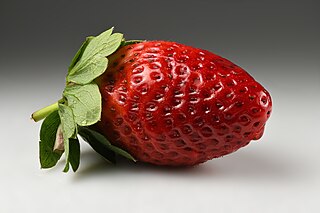
The Sesiidae or clearwing moths are a diurnal moth family in the order Lepidoptera known for their Batesian mimicry in both appearance and behaviour of various Hymenoptera.

The garden strawberry is a widely grown hybrid species of the genus Fragaria, collectively known as the strawberries, which are cultivated worldwide for their fruit. The fruit is widely appreciated for its characteristic aroma, bright red color, juicy texture, and sweetness. It is consumed in large quantities, either fresh or in such prepared foods as jam, juice, pies, ice cream, milkshakes, and chocolates. Artificial strawberry flavorings and aromas are also widely used in products such as candy, soap, lip gloss, perfume, and many others.

The hornet moth or hornet clearwing is a large moth native to Europe and the Middle East and has been introduced to North America. Its protective coloration is an example of Batesian mimicry, as its similarity to a hornet makes it unappealing to predators. The hornet moth has been linked to the large dieback of poplar trees across Europe because its larvae bore into the trunk of the tree before re-emerging as adults.

Synanthedon tipuliformis, known as the currant clearwing, is a moth of the family Sesiidae. It is endemic to the Palearctic realm, but is an invasive species in the Nearctic realm and the Australasian realm.

Synanthedon vespiformis, the yellow-legged clearwing, is a moth of the family Sesiidae. It is found in the Palearctic realm.

Bembecia ichneumoniformis, the six-belted clearwing, is a moth of the family Sesiidae.

Pennisetia marginata, the raspberry crown borer or blackberry clearwing borer, is a moth of the family Sesiidae. The species was first described by Thaddeus William Harris in 1839. It is widespread in the United States, mainly in the east and along the Pacific Coast, ranging north into the southern parts of Canada. It is an introduced species in Hawaii.
Oligophlebia is a genus of moths in the family Sesiidae, the clearwing moths. They are native to the Palearctic realm.

Sesia tibialis, the American hornet moth, poplar clearwing borer or cottonwood crown borer, is a moth of the family Sesiidae. It is known from North America, including British Columbia, Colorado, Utah, Michigan, Montana, Washington, California and Arizona.
Camaegeria aristura is a moth of the family Sesiidae. It is known from Uganda.
Camaegeria sophax is a moth of the family Sesiidae first described by Herbert Druce in 1899. It is known from Malawi, Mozambique, Uganda and Zimbabwe.
Camaegeria sylvestralis is a moth of the family Sesiidae. It is known from eastern Madagascar.

Microsphecia brosiformis is a moth of the family Sesiidae. It is found from the Balkan Peninsula to the Crimea, southern Russia (Sarepta), Asia Minor, the Caucasus, Iran, Turkmenistan and Afghanistan.

Bembecia scopigera, the six-belted clearwing, is a moth of the family Sesiidae. It is found from central Spain over most of south-western and central Europe, the Balkans, Greece, southern Russia and Ukraine to Turkey.

Pyropteron triannuliformis is a moth of the family Sesiidae. It is found from most of Europe to the Near East and Central Asia.

Chamaesphecia masariformis is a moth of the family Sesiidae. It is found in south-eastern Europe, Turkey, northern Iran, the Middle East, the Caucasus, southern Russia, Uzbekistan and Tajikistan.
Camaegeria monogama is a moth of the family Sesiidae. It is known from Sierra Leone.

Heterosphecia tawonoides, the oriental blue clearwing, is a moth of the family Sesiidae, in the genus Heterosphecia. The sesiids are mimics, in general appearance similar to a bee or wasp. This species was described in 2003 by Axel Kallies, from a specimen collected in 1887.












